Posted by Elena del Valle on November 16, 2011

Le Wang, assistant professor, economics, University of New Hampshire
Photo: University of New Hampshire
Marketers targeting Hispanic immigrant men take note. A change in immigration policies after September 11 at federal and state levels and heightened immigration enforcement efforts may have changed the living conditions of Hispanic immigrants and increased their incentives to marry natives. A recent study indicates Hispanic immigrants, men specifically, have become more likely to marry natives post 9/11 than before that date.
According to the study, marriages between Hispanic immigrants and natives increased by more than 2 percent in the decade following the attacks of September 11. In the first two years after 9/11 there was a small increase in marriages to natives while in the years after that the increase became yet more noticeable.
These marriages helped offset the deterioration in job prospects for Hispanic immigrants that resulted from discrimination following the attacks, according to new research from the University of New Hampshire.
“Being married to a native increases employment rates by 1.2 percent and earnings by 21.8 percent,” according to researchers at the University of New Hampshire and the University of Massachusetts at Dartmouth. “The offsetting effect may not be particularly large, given the estimated effect of Sept. 11 on intermarriage being about 2 percent. Nevertheless, this result highlights the possible importance of the labor market incentives that are associated with the increased rates of intermarriage among Hispanics.”
The researchers believe their results reflect the actions of undocumented immigrants, Hispanic immigrants marrying Hispanic natives, immigrants who were married before arrival, or new immigrants; and call for further research to better understand the intermarriage behaviors of Hispanics.
An article about the research titled The effects of 9/11 on intermarriage between natives and immigrants to the U.S. was published September 2011 in the Review of Economics of the Household and was the work of Le Wang, assistant professor, economics, University of New Hampshire, and Chunbei Wang, assistant professor, economics, University of Massachusetts at Dartmouth. The researchers analyzed the March Current Population Survey 1995-2010 and relied on a difference-in-differences approach to estimate the impact of 9/11 on intermarriage among Hispanic immigrants.
Posted by Elena del Valle on November 14, 2011

World No Tobacco campaign ad
Photos: vi.sualize.us, Campaign for Tobacco-Free Kids
Some 400,000 people die each year from their own cigarette smoking and another 50,000 adult nonsmokers die each year from exposure to secondhand smoke; there are six million children under 18 alive today who may eventually die from smoking; and 8.6 million people in the United States currently suffer from smoking-caused illness, according to the Campaign for Tobacco-Free Kids, a Washington, D.C. based nonprofit advocacy organization that strives to save lives by advocating for public policies that prevent kids from smoking.”
Many young Americans, whites and Hispanics may be opposed to smoking. More than half of respondents to a national telephone survey of 1,110 registered voters conducted October 23, 2011 disapproved of people who smoke; 52 percent of respondents asked whether they frown on people who smoke said yes, 31 percent said they did not and 17 percent had no opinion. Young survey participants, in the 18-29 year old age group, were the most likely, at 63 percent, to say they frown on smokers.
Although 54 percent of white respondents and 48 percent of Hispanic respondents said they disliked smokers, 51 percent of African-Americans said they do not frown on people who smoke. Among women respondents 53.2 percent said they frowned on smokers compared to 50.5 percent of men who said they frowned on smokers.
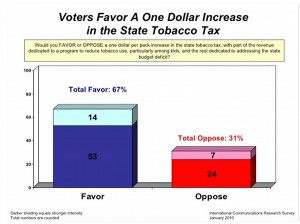
Two-thirds of voters polled supported increasing the state tobacco tax – click to enlarge
Curiously political orientation had little influence on opinions about smokers among respondents of that survey. The difference between Republicans, 54 percent, and Democrats, 53 percent, not happy with smokers was only 1 percent while fewer Independents, 48 percent, said they frowned on smokers. The survey was conducted and paid for by Poll Position, a non-partisan news, polling, and social media company.
A January 2010 national telephone survey of 847 registered voters conducted through an International Communications Research Excel study indicated that two-thirds of voters polled supported increasing the state tobacco tax by $1.00 per pack.
An older national survey, from 2006, of 1,000 likely general election voters with an oversampling of black and Hispanics voters found Hispanics to be the most supportive of smoke-free laws. In the Mellman Group survey 69 percent of respondents said they favored smoke-free laws; 69 percent of whites, 65 percent of blacks and 78 percent of Hispanics favored such laws. More women, 74 percent, than men, 64 percent, more Democrats, 73 percent, than Republicans, 67 percent, favored the smoke-free laws.
Posted by Elena del Valle on November 9, 2011

Juan Motta, head, Nestlé’s Emerging Markets
Photo: Nestlé USA
Executives at Swiss owned Nestlé want to reach Spanish dominant Hispanics in the United States with Construye el Mejor Nido (Spanish for Create the Best Nest), a new communication platform that offers Nestlé’s nutrition, health and wellness resources to Spanish speakers. The program was announced at the end of September 2011 in time to mark the year’s Hispanic Heritage Month.
According to promotional materials, elements of the program, which marks several firsts for the company, include efforts on Spanish language television, Facebook, a bilingual website, in store marketing, and product sampling packs. It is the first time the company launches an integrated multi-brand platform for consumers and shoppers in the United States; the first time Nestlé USA plans a corporate branded TV campaign; the first time Nestlé iconography of the nest concept is leveraged as a concept domestically; and the first time Nestlé USA plans to leverage its equity and drive associations between the Nestlé brand and individual brands.
The company released three television ads designed to demonstrate how Nestlé products “fit into Hispanic consumers’ everyday life and help them to nurture their family’s lives.” The ads are also designed to leverage and reinforce Nestlé’s iconography of the nest in the Nestlé corporate logo which executives hope conveys family, trust and well-being to Hispanics.
“Hispanic Heritage Month is the perfect time for Nestlé USA to reaffirm its strong history of awareness, trust and expertise among Hispanic consumers,” said Juan Motta, head, Nestlé’s Emerging Markets. “This awareness and trust stems from a strong emotional connection with authentic Nestlé brands in consumers’ home countries such as Nescafé, Abuelita, Nido and La Lechera. Construye el Mejor Nido provides consumers with information on familiar brands, as well as with other Nestlé brands available in the U.S. such as Juicy Juice and Stouffer’s.”
Believing that Facebook reaches 98 percent of Hispanic women 35 to 49 who go online Nestlé USA established Facebook.com/ElMejorNido. The page, which features contributions from Hispanic bloggers, is meant to provide a brand and cultural connection, and a place where visitors can share recipes and tips. To further its online reach the company established ElMejorNido.com, a bilingual website that promises blogger contributions, tips, articles, food videos and information on wellness, culture and parenting. The site also offers Nestlé the means to build a marketing list by providing visitors the option to receive information from the company.
Construye El Mejor Nido, an in-store effort, was designed to reach Hispanic shoppers in independent and mainstream stores through in-store circulars, bilingual door hangers, and recipe booklets. Nestlé plans to introduce new products and connect with Latino consumers by providing Fiesta Packs with new products, recipes, and party supplies to select Hispanic families. The company’s promotional materials indicate the Construye El Mejor Nido program has been well received by consumers, with traffic to the website and Facebook page exceeding expectations.
Posted by Elena del Valle on October 26, 2011
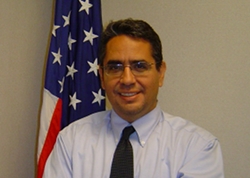
P. David Lopez, general counsel, EEOC
Photos: U.S. Equal Employment Opportunity Commission
Bass Pro Outdoor World, LLC (Bass Pro), a retailer of sporting goods and apparel, in the United States and Canada, allegedly engaged in a pattern or practice of failing to hire African-American and Hispanic applicants for positions in its retail stores nationwide, and retaliated against employees who opposed the discriminatory practices, according to a lawsuit files recently by the U.S. Equal Employment Opportunity Commission (EEOC). The retailer retaliated against employees who opposed discrimination, and destroyed records, the agency said in a press release.
According to the EEOC’s suit filed in U.S. District Court for the Southern District of Texas, Houston Division (Civil Action No. 4:11-CV-3425), Bass Pro has been discriminating in its hiring since at least November 2005. The EEOC’s suit alleges that qualified African-Americans and Hispanics were routinely denied retail positions such as cashier, sales associate, team leader, supervisor, manager and other positions at many Bass Pro stores nationwide.
The lawsuit alleges that managers at Bass Pro stores in the Houston area, in Louisiana, and elsewhere made overtly racially derogatory remarks acknowledging the discriminatory practices, including that hiring black candidates did not fit the corporate profile.
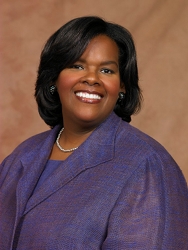
Jacqueline A. Berrien, chair, EEOC
“Excluding qualified individuals from employment because of their race or ethnicity or in retaliation for exercising protected rights are fundamental violations of the laws we enforce,” said Jacqueline A. Berrien, chair, EEOC. “The EEOC will diligently protect the rights of job applicants to ensure that hiring decisions are based on abilities, not on race or ethnicity.”
The lawsuit also claims that Bass Pro unlawfully destroyed or failed to keep records and documents related to employment applications and internal discrimination complaints. Agency representatives believe also, that Bass Pro punished employees who opposed the company’s unlawful practices, in some instances firing them or forcing them to resign.
This alleged behavior violates Title VII of the Civil Rights Act of 1964, which prohibits discrimination based on race and national origin, and prohibits employers from retaliating against employees who complain about employment discrimination and requires them to keep certain employment records. In 2010, the EEOC was aware of 1,822 cases of discrimination based on country of origin, color or race and 511 cases of retaliation.
“As a law enforcement agency, the EEOC is uniquely positioned to challenge systemic hiring discrimination,” said P. David Lopez, general counsel, EEOC. “It is unlawful for employers to deny jobs to applicants based on their race or national origin and the EEOC will vigorously pursue such cases and require companies to reform their hiring practices and make victims of the discrimination whole.”
The EEOC’s administrative investigation culminated in findings of class-wide hiring discrimination based on statistical and anecdotal evidence, and retaliation. The EEOC attempted to reach a voluntary settlement with Bass Pro before filing suit. The lawsuit seeks a permanent injunction prohibiting Bass Pro from engaging in race discrimination, national origin discrimination, retaliation, and improper record destruction. It also seeks back pay on behalf of victims of hiring discrimination and/or retaliation, compensatory and punitive damages and other relief, including implementing fair recruitment and hiring procedures, and reinstatement or rightful-place hiring of mistreated job applicants and former employees.
“We will hold employers accountable for depriving qualified minority workers of good jobs simply because of their race or national origin,” said Jim Sacher, Houston regional attorney, EEOC. “Such behavior is always out of season.”
The agency is seeking the assistance of individuals who believe they may have been denied a position at Bass Pro because of their race (African-American or black) or ethnicity (Hispanic or Latino) or who have any information that would be helpful to the EEOC’s suit against Bass Pro through the EEOC toll free number at (855) 857-8747 or by e-mail at Basspro.lawsuit@eeoc.gov.
Posted by Elena del Valle on October 19, 2011

Photo, graphic: Hispanic Association of Colleges and Universities (HACU)
Degree-granting academic institutions with Full-Time Equivalent undergraduate enrollments of 25 percent or more of Hispanic are defined as Hispanic Serving Institutions (HSIs) by the Higher Education Act. In 2010, there were 311 such institutions with an enrollment of 1,348,513 Hispanic students in post secondary non-profit schools, according to the Hispanic Association of Colleges and Universities (HACU), a 400-member organization founded in 1986 by 18 original colleges and universities to be “the champion of Hispanic higher education.”
HIS institutions receive 66 cents for every dollar allocated to other institutions of higher learning every year per student from federal funding sources. Although these institutions enrolled 16 percent of all students in post secondary non profit schools, and served 54 percent of all Hispanic students they represented 9 percent of non profit colleges and universities in the country.

John Moder, Ph.D., senior vice president and chief operating officer, Hispanic Association of Colleges and Universities
“Hispanic-Serving Institutions (HSIs) are playing the key role in Hispanic higher education, since these 300 institutions enroll more than half the Latinos in US colleges and universities. As the Hispanic college population has grown, so has the number of HSIs. Addressing the achievement gap or reaching the President’s goal of becoming number one in the world in degree attainment will require more attention to (and more funding for) these institutions that are already educating most the nation’s largest and fastest-growing minority population,” said John Moder, Ph.D., senior vice president and chief operating officer, Hispanic Association of Colleges and Universities, by email in response to a question about the importance of these institutions and the significance of their growth in the past decade.
Of the 311 HSIs in 2010, 152 (49 percent) were public two-year institutions, 65 public four-year institutions, 82 private four-year institutions, and 12 private two year institutions.
California, with 98 HSIs had the most such institutions of any state followed by 56 each in Puerto Rico and Texas, 23 in New Mexico, 15 each in Florida and New York, 13 in Illinois, 10 in Arizona, 6 in New Jersey, 5 in Colorado, 4 in Kansas, 3 each Massachusetts and Washington, 2 in Connecticut, and 1 each in Indiana and Oregon.
Posted by Elena del Valle on October 12, 2011
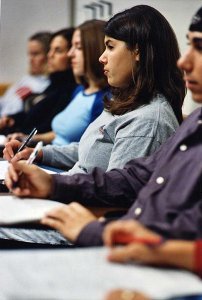
In 2010, 1 million Hispanics had an advanced degree
Photo: U.S. Census Bureau, Public Information Office (PIO)
The latest United States Census has broadened our knowledge of the national population including size and demographic trends, and provided a picture of the largest ethnic group’s growth. According to the Census, last year there were 50.5 million Hispanics in the country; they represented just over 16 percent of the population.
While the Hispanic market grew 43 percent in the last decade (2000 to 2010) the fastest growth for Hispanics was in the South and Midwest. More than three quarters of Latinos live in eight states: California, Texas, Florida, New York, Arizona, Illinois, New Jersey and Colorado.
The Hispanic population is younger than the mainstream. The median age among Hispanics is 27.4 for Hispanics.
When it comes to education there is room for improvement: 64 percent of Hispanic high school graduates ages 16-24 were enrolled in college in 2008, compared to 72 percent for non-Hispanic whites. In higher education the difference was greater: 13.9 percent of Latinos had a bachelor’s degree compared to 30.3 percent for the mainstream, and 4 percent had an advanced degree compared to 10.7 percent for non Hispanic whites.
In 2010, 2.4 million Hispanics including those in Puerto Rico were enrolled in college. Almost half (49 percent) of Hispanic college students attended a two-year institution compared to 37 percent of all college students.
Seen another way, in 2010, 63 percent of Hispanics 25 and older had a high school education or higher; there were 3.9 million Hispanics 18 and older with a bachelor’s degree or higher; 1 million Hispanics 18 and older had an advanced degree (see Educational Attainment in the United States: 2010 Detailed Tables)
.
In 2009, 12 percent of college students, undergraduate and graduate students, were Hispanic; and 20 percent of elementary and high school students were Hispanic (see School Enrollment – Social and Economic Characteristics of Students: October 2009).
Posted by Elena del Valle on October 9, 2011
PPFA is currently seeking an experienced speechwriter. S/he will play an instrumental role in developing core speech content for the President of PPFA. This position will be responsible for drafting full length speeches, brief remarks, talking points and speech frameworks for the President and from time to time key senior staff. The Speechwriter will partner with the PPFA President, the Director of the OOP, the Vice President of Communications, divisional heads and other key leaders across the country to develop original content and ensure that key messages are consistently communicated across multiple channels (speeches/speaker forums, web, internal communications and events).
A full position description and application instructions may be found
at: https://plannedparenthoodext.hire.com/viewjob.html?optlink-view=view-59210
Applications are due by October 14, 2011.
Posted by Elena del Valle on October 9, 2011
Looking for a high-energy, self-starter to provide programmatic and administrative support to the Director of Latino Engagement at PPFA. The ideal candidate will be a natural organizer, who learns and processes quickly, can think on her or his feet and work with a wide variety of people coming from different backgrounds.
For a full position description and application instructions, please visit: https://plannedparenthoodext.hire.com/viewjob.html?optlink-view=view-63587
Applications are due by October 14, 2011.
Posted by Elena del Valle on October 3, 2011
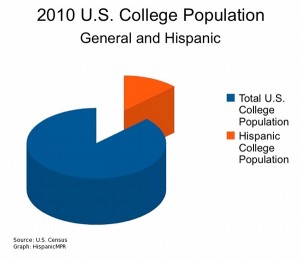
2010 college population – click to enlarge
Marketers and businesses targeting college youth should be aware that the demographic profile of college students is shifting. For many this is not surprisingly given the 2010 United States Census results. Last year there were 320,000 fewer non Hispanic whites in college compared to the year before. At the same time, the number of Hispanics in college for the same period increased by more than the decrease of non Hispanic whites.
There are approximately 12.2 million students attending higher educational institutions in the United States according to the Census. Of those about 1.8 million are Hispanics attending for profit and non profit institutions.
In 2009, there were 2,286,261 Hispanic undergraduate and graduate students at non profit institutions in the United States and Puerto Rico. By 2010 that number had increased to 2,476,417 resulting in an increase of 190,156, according to the Hispanic Association of Colleges and Universities (HACU). That organization’s source of data is Integrated Postsecondary Education Data System (IPEDS), Pew Hispanic Center Reports, The Condition of Education 2011, and the Digest of Education Statistics 2010.

Antonio Flores, Ph.D., president and CEO, HACU
“We have seen a steady increase in the number of Hispanics entering higher education over the last several decades. The only surprising thing about this year’s increase is its size. Such a large one year increase in Hispanic enrollments underlines the importance of acting now to assure college and career readiness for this population which already makes up half of those entering the American workforce today but are still handicapped by low college attendance and completion rates,” said Antonio Flores, Ph.D., president and chief executive officer, HACU.
The Census data reflects 350,000 new Hispanic students attending college, a 24 percent increase between 2009 and 2010. That number is higher than the 190,156 increase above because it includes for profit and non profit organizations.
The largest increase of students in non-profit institutions from 2009 to 2010 was in California (71,952), Texas (52,464), New Mexico (5,538), New Jersey (5,428), and Florida (5,372). Hispanic student percentage distribution of fall 2009 enrollment: New Mexico, 42.4 percent; California, 30.3 percent; Texas, 29.7 percent; and Florida, 20.9 percent.
Posted by Elena del Valle on September 21, 2011
By Neil Tortorella

Neil Tortorella
Photo: Courtesy of Neil Tortorella
Press and public relations (P.R.) can be two of the most powerful tools in a business’ marketing toolbox. When managed correctly, they add significant credibility for both the business and its key employees. Plus, p.r. is often less expensive than advertising and can be more believable. From the audience’s point-of-view, a well-placed story, article or interview can be seen as a third party endorsement of the company and/or its leaders.
A public relations program should begin with a simple question – What are you trying to accomplish? When the answer is sharply focused, sensible, strategic and attainable goals can be developed. Just like your business’ overall marketing efforts it all starts with a plan. What steps must you take to get there? Becoming a household name overnight probably isn’t likely, although it can happen. Targeting some local, regional or niche recognition might be a little more achievable.
Click to read the entire article The Potent Power of Press Relations





















